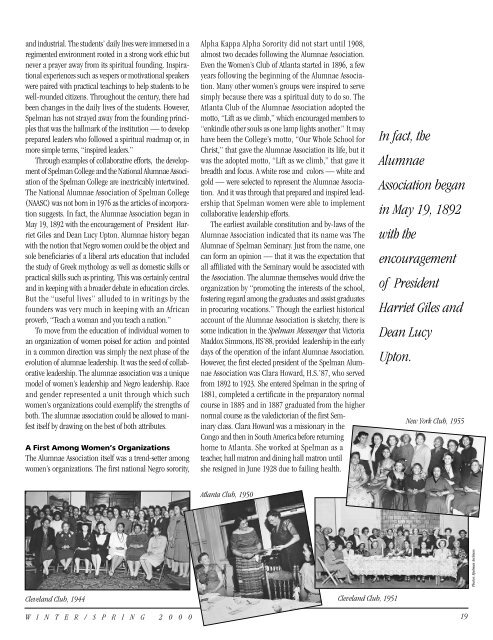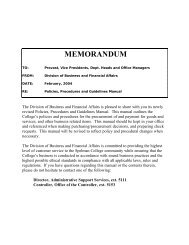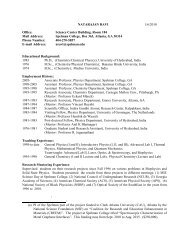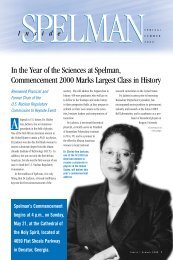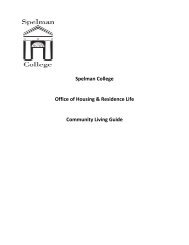(Vol. 114 No. 1) Text (PDF) - Spelman College: Home
(Vol. 114 No. 1) Text (PDF) - Spelman College: Home
(Vol. 114 No. 1) Text (PDF) - Spelman College: Home
- No tags were found...
You also want an ePaper? Increase the reach of your titles
YUMPU automatically turns print PDFs into web optimized ePapers that Google loves.
and industrial. The students’ daily lives were immersed in aregimented environment rooted in a strong work ethic butnever a prayer away from its spiritual founding. Inspirationalexperiences such as vespers or motivational speakerswere paired with practical teachings to help students to bewell-rounded citizens. Throughout the century, there hadbeen changes in the daily lives of the students. However,<strong>Spelman</strong> has not strayed away from the founding principlesthat was the hallmark of the institution — to developprepared leaders who followed a spiritual roadmap or, inmore simple terms, “inspired leaders.”Through examples of collaborative efforts, the developmentof <strong>Spelman</strong> <strong>College</strong> and the National Alumnae Associationof the <strong>Spelman</strong> <strong>College</strong> are inextricably intertwined.The National Alumnae Association of <strong>Spelman</strong> <strong>College</strong>(NAASC) was not born in 1976 as the articles of incorporationsuggests. In fact, the Alumnae Association began inMay 19, 1892 with the encouragement of President HarrietGiles and Dean Lucy Upton. Alumnae history beganwith the notion that Negro women could be the object andsole beneficiaries of a liberal arts education that includedthe study of Greek mythology as well as domestic skills orpractical skills such as printing. This was certainly centraland in keeping with a broader debate in education circles.But the “useful lives” alluded to in writings by thefounders was very much in keeping with an Africanproverb, “Teach a woman and you teach a nation.”To move from the education of individual women toan organization of women poised for action and pointedin a common direction was simply the next phase of theevolution of alumnae leadership. It was the seed of collaborativeleadership. The alumnae association was a uniquemodel of women’s leadership and Negro leadership. Raceand gender represented a unit through which suchwomen’s organizations could exemplify the strengths ofboth. The alumnae association could be allowed to manifestitself by drawing on the best of both attributes.A First Among Women’s OrganizationsThe Alumnae Association itself was a trend-setter amongwomen’s organizations. The first national Negro sorority,Alpha Kappa Alpha Sorority did not start until 1908,almost two decades following the Alumnae Association.Even the Women’s Club of Atlanta started in 1896, a fewyears following the beginning of the Alumnae Association.Many other women’s groups were inspired to servesimply because there was a spiritual duty to do so. TheAtlanta Club of the Alumnae Association adopted themotto, “Lift as we climb,” which encouraged members to“enkindle other souls as one lamp lights another.” It mayhave been the <strong>College</strong>’s motto, “Our Whole School forChrist,” that gave the Alumnae Association its life, but itwas the adopted motto, “Lift as we climb,” that gave itbreadth and focus. A white rose and colors — white andgold — were selected to represent the Alumnae Association.And it was through that prepared and inspired leadershipthat <strong>Spelman</strong> women were able to implementcollaborative leadership efforts.The earliest available constitution and by-laws of theAlumnae Association indicated that its name was TheAlumnae of <strong>Spelman</strong> Seminary. Just from the name, onecan form an opinion — that it was the expectation thatall affiliated with the Seminary would be associated withthe Association. The alumnae themselves would drive theorganization by “promoting the interests of the school,fostering regard among the graduates and assist graduatesin procuring vocations.” Though the earliest historicalaccount of the Alumnae Association is sketchy, there issome indication in the <strong>Spelman</strong> Messenger that VictoriaMaddox Simmons, HS’88, provided leadership in the earlydays of the operation of the infant Alumnae Association.However, the first elected president of the <strong>Spelman</strong> AlumnaeAssociation was Clara Howard, H.S.’87, who servedfrom 1892 to 1923. She entered <strong>Spelman</strong> in the spring of1881, completed a certificate in the preparatory normalcourse in 1885 and in 1887 graduated from the highernormal course as the valedictorian of the first Seminaryclass. Clara Howard was a missionary in theCongo and then in South America before returninghome to Atlanta. She worked at <strong>Spelman</strong> as ateacher, hall matron and dining hall matron untilshe resigned in June 1928 due to failing health.In fact, theAlumnaeAssociation beganin May 19, 1892with theencouragementof PresidentHarriet Giles andDean LucyUpton.New York Club, 1955Atlanta Club, 1950Photos: <strong>Spelman</strong> ArchivesCleveland Club, 1944Cleveland Club, 1951W I N T E R / S P R I N G 2 0 0 019


